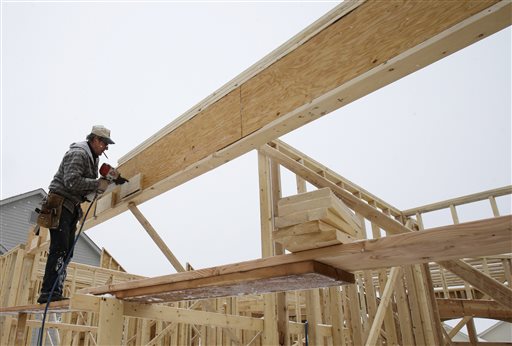US home prices rise modestly, weigh on affordability

In this Wednesday, Feb. 18, 2015 photo, builder Janez Bratkovic prepares to put in a header on a new home construction in Pepper Pike, Ohio. The New York-based Conference Board on Thursday, March 19, 2015 said its index of leading indicators rose by a modest amount for a second straight month, indicating the economy’s momentum may have slowed. AP
WASHINGTON — US home prices rose at a steady pace in January, pushing prices up at a faster pace than wages and putting more homes financially out of reach for would-be buyers.
The Standard & Poor’s/Case-Shiller 20-city home price index rose 4.6 percent in January compared with 12 months earlier, S&P said Tuesday. That is up from growth of 4.4 percent in December.
Few Americans have listed their homes for sale, and the tight supply has kept prices higher. The increases have eclipsed earnings, making it more difficult for buyers to save for a down payment and afford a monthly mortgage. The modest wage gains have diminished the boost that robust hiring and low mortgage rates should provide the housing market during the spring buying season.
“Home prices are rising roughly twice as fast as wages, putting pressure on potential homebuyers and heightening the risk that any uptick in interest rates could be a major setback,” said David Blitzer, chairman of the index committee for S&P Dow Jones Indices
The Case-Shiller index covers roughly half of U.S. homes. The index measures prices compared with those in January 2000 and creates a three-month moving average. The January figures are the latest available.
Housing inventories have been tight since December. The number of homes for sale in February was equal to just 4.6 months of sales, compared to an average of 5.2 months last year. Six months of supply is typical for a healthy housing market.
All 20 cities reported higher prices than a year earlier. Denver reported the largest gains, with prices up 8.4 percent. Miami prices jumped by 8.3 percent, while Dallas homes appreciated at 8.1 percent. Home appreciation nearly plateaued in Washington, DC, where prices rose just 1.3 percent.
Signed contracts in February suggest that sales will rebound after a sluggish start to 2015, when sales were running below last year’s relatively pace.
The number of signed contracts rose 3.1 percent last month, which should be reflected by more sales being completed in March and April, according to the National Association of Realtors.
A new housing indicator by the insurer Nationwide suggests that the housing market was stable at the end of 2014. That index released Tuesday said the housing market is at its healthiest level since 2001, with few regional markets at risk of a downturn.
Based on employment, demographics, mortgages and home prices, the index found the healthiest markets to be in Pittsburgh, Cleveland and Philadelphia metro areas.
Historically low mortgage rates and solid hiring have laid the foundation for stronger sales this year.
Average 30-year fixed rates were 3.69 percent last week, according to the mortgage giant Freddie Mac. The average has plummeted from a 52-week high of 4.41 percent, making it cheaper for would-be homeowners to buy.
Separately, employers have added 3.3 million jobs over the past 12 months, including 295,000 jobs in February. The hiring spree pace has caused the unemployment rate to drop to 5.5 percent from 6.7 percent. As more people in the economy hold jobs, more paychecks exist to fund home purchases.
RELATED STORIES
US eyes security issues in sale of NY’s Waldorf hotel to Chinese firm
Vista Land USA vows to make buying property in PH ‘safe and easy’